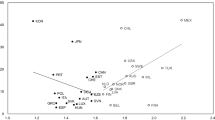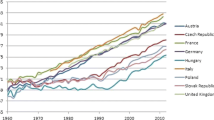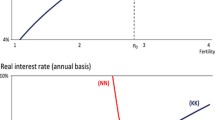Abstract
We analyze the effect of population aging on the political choice of the size of a pay-as-you-go (PAYG) social security system, incorporating the heterogeneity of individuals in their preference for having children, and hence the endogenous fertility choices of individuals, into a simple overlapping generations model. We show that population aging may result in an increase in the contribution rate, increasing the share of the retired population who prefer a higher contribution rate; and that, if the system involves redistribution between retirees with different contributions, the increased contribution rate raises the number of individuals who have children, i.e., future contributors.

Similar content being viewed by others
Notes
See several papers including Razin and Sadka (2007) in “Current controversies: Ageing and the welfare state” in the European Journal of Political Economy 23 (2007).
In the absence of annuity markets, our conclusion essentially holds if accidental bequests are distributed equally among children.
When the social security benefits depend on the length of the working period, i.e., when 1 > σ ≥ 1-εñ, the imperfection of redistribution affects the fertility rate. However, the effect may not overwhelm the opportunity cost effect in plausible cases. The results in case 1 > σ ≥ 1-εñ are available from the authors upon request.
Cigno and Rosati (1996: Table 2 on p. 1577) among others showed the negative relationship between female wage rates and fertility, in contrast to the positive relationship between male wages and fertility, for Germany, Italy, and UK, while the coefficients of female wages are greater than those of males. Since we assume unisex individuals in our paper, the prediction that a decrease in the after-tax wage rate (i.e., an increase in the contribution rate) raises the fertility rate in the economy is not necessarily inconsistent with their observations. See also Cigno and Werding (2007).
Even with this assumption, we can not rule out the possibility of the corner solutions because τ∈[0,1]. However, our result is valid even for the corner solutions as long as τ N <τ P.
In this case we can show that \({\mbox{d}U_t^P \left( {\tau ^R} \right)} \mathord{\left/ {\vphantom {{\mbox{d}U_t^P \left( {\tau ^R} \right)} {\mbox{d}\tau _t <0}}} \right. \kern-\nulldelimiterspace} {\mbox{d}\tau _t <0}\). Theoretically, of course, one can not exclude a priori a case in which the opposite inequality holds. In that case we may have τ P ≥τ R. It seems rather plausible that at higher contribution rates the direct cost of an increase in the rate will overwhelm the benefits from the resultant population growth.
References
Breyer F, Stolte K (2001) Demographic change, endogenous labor supply and the political feasibility of pension reform. J Popul Econ 14:409–424
Browning EK (1975) Why the social insurance budget is too large in a democratic society. Econ Inq 13:373–388
Casamatta G, Cremer H, Pestieau P (2000) The political economy of social security. Scand J Econ 102:503–522
Cigno A, Rosati FC (1996) Jointly determined saving and fertility behaviour: theory, and estimates for Germany, Italy, UK and USA. Eur Econ Rev 40:1561–1589
Cigno A, Werding M (2007) Children and Pensions. MIT Press, Cambridge
Cooley TF, Soares J (1999) Will social security survive the baby boom? Carnegie-Rochester Conf Ser Public Policy 45:89–121
Disney R (2007) Population ageing and the size of the welfare state: is there a puzzle to explain? Eur J Polit Econ 23:542–553
Galasso V, Profeta P (2002) The political economy of social security: a survey. Eur J Polit Econ 18:1–29
Galasso V, Profeta P (2007) How does ageing affect the welfare state? Eur J Polit Econ 23:554–563
Razin A, Sadka E (2007) Aging population: the complex effect of fiscal leakages on the politico-economic equilibrium. Eur J Polit Econ 23:564–575
Razin A, Sadka E, Swagel P (2002) The aging population and the size of the welfare state. J Polit Econ 110:900–918
Tabellini G (2000) A positive theory of social security. Scand J Econ 102:523–545
Wigger BU (2001) Productivity growth and the political economy of social security. Public Choice 106:53–76
Yakita A (2001) Uncertain lifetime, fertility and social security. J Popul Econ 14:635–640
Zhang J, Zhang J, Lee R (2001) Mortality decline and long-run economic growth. J Public Econ 80:485–507
Acknowledgements
The authors would like to thank two anonymous referees and Alessandro Cigno, the editor of this journal. We are also indebted to Masatoshi Jin-no, Yukio Karasawa, Murray C. Kemp, Kazutoshi Miyazawa, and the seminar participants at the Nagoya Macroeconomics Workshop for their helpful comments. This research is financially supported by the Postal Life Insurance Foundation of Japan (Zaidan Hojin Kan-i Hoken Bunka Zaidan, 2006).
Author information
Authors and Affiliations
Corresponding author
Additional information
Responsible editor: Alessandro Cigno
Rights and permissions
About this article
Cite this article
Hirazawa, M., Kitaura, K. & Yakita, A. Aging, fertility, social security and political equilibrium. J Popul Econ 23, 559–569 (2010). https://doi.org/10.1007/s00148-008-0203-x
Received:
Accepted:
Published:
Issue Date:
DOI: https://doi.org/10.1007/s00148-008-0203-x




